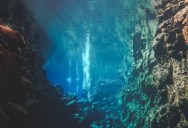A New Microcontinent Was Recently Discovered Right Between Canada And Greenland

You might think that, even if there are still mysteries about the earth and the past and the universe, the general landscape of the world pretty much is what it is.
But, you would be wrong.
Enter what researchers say is a small continent between Canada and Greenland.
It’s in the Davis Strait between Baffin Island, off the southeastern coast of Canada, and southwestern Greenland.
The island was found using gravity data and seismic reflection data that created a plate tectonic reconstruction of the region.

The researchers say this area has always been a bit mysterious.
“A prolonged period of rifting and seafloor spreading between Greenland and North America formed the Labrador Sea and Baffin Bay oceanic basins. connected by the Davis Strait. However, disagreement exists regarding the exact plate motions between Greenland and Canada, as well as the tectonic evolution of the Davis Strait, with previous models unable to explain the origin of anomalously thick continental crust within the seaway.”
That’s how they found a tectonic block that became detached from Canada or Greenland in the distant past.
“The reinterpretation of seismic reflection data offshore West Greenland, along with a newly compiled crustal thickness model, identifies an isolated terrane of relatively thick continental crust that was separated from Greenland during a newly recognized phase of E-W extension along West Greenland’s margin. We interpret this continental block as an incompletely rifted microcontinent, which we term the Davis Strait proto-microcontinent.”
They believe the rifting began around 118 million years ago, before the continental breakup happened 61.27 million years ago in the Labrador Sea.
The continents drifted apart until Greenland collided with and joined the North American plate, creating this microcontinent in the process.
“As our seismic reflection interpretations indicate and extensional event in the eastern Davis Strait between 58 and 49 Myr, spatially coincident with the zone of the thinnest continental crust between the continental fragment and Greenland, we infer this extensional event led to the separation of this fragment from Greenland.”

They hope that learning more about this microcontinent could help us understand the hazards plate tectonics can cause for human beings.
“Overall, this work not only recognizes several new first order tectonic features of the Earth, the Pre-UTM and Davis Strait proto-microcontinent, but also points to a strong lithospheric control on plate motion directions. It is therefore fundamentally important to further study this phenomenon to understand the operation of plate tectonics on our planet.”
It’s always cool to realize there is so much to learn still about our own planet.
At least, I think so.
Thought that was fascinating? Here’s another story you might like: Why You’ll Never See A Great White Shark In An Aquarium

Sign up to get our BEST stories of the week straight to your inbox.




